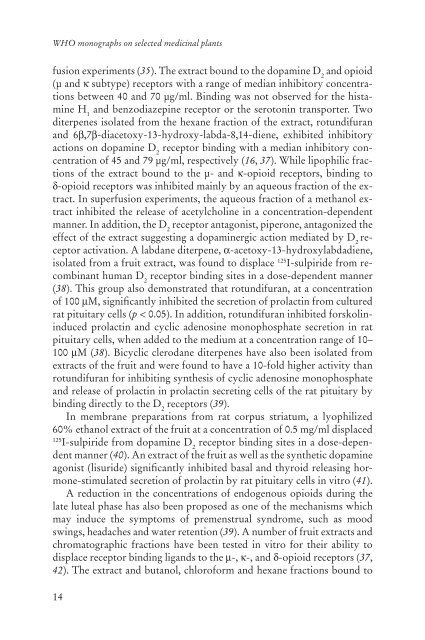WHO monographs on selected medicinal plants - travolekar.ru
WHO monographs on selected medicinal plants - travolekar.ru
WHO monographs on selected medicinal plants - travolekar.ru
You also want an ePaper? Increase the reach of your titles
YUMPU automatically turns print PDFs into web optimized ePapers that Google loves.
<str<strong>on</strong>g>WHO</str<strong>on</strong>g> <str<strong>on</strong>g>m<strong>on</strong>ographs</str<strong>on</strong>g> <strong>on</strong> <strong>selected</strong> <strong>medicinal</strong> <strong>plants</strong><br />
fusi<strong>on</strong> experiments (35). The extract bound to the dopamine D 2<br />
and opioid<br />
(μ and subtype) receptors with a range of median inhibitory c<strong>on</strong>centrati<strong>on</strong>s<br />
between 40 and 70 μg/ml. Binding was not observed for the histamine<br />
H 1<br />
and benzodiazepine receptor or the serot<strong>on</strong>in transporter. Two<br />
diterpenes isolated from the hexane fracti<strong>on</strong> of the extract, rotundifuran<br />
and 6,7-diacetoxy-13-hydroxy-labda-8,14-diene, exhibited inhibitory<br />
acti<strong>on</strong>s <strong>on</strong> dopamine D 2<br />
receptor binding with a median inhibitory c<strong>on</strong>centrati<strong>on</strong><br />
of 45 and 79 μg/ml, respectively (16, 37). While lipophilic fracti<strong>on</strong>s<br />
of the extract bound to the μ- and -opioid receptors, binding to<br />
-opioid receptors was inhibited mainly by an aqueous fracti<strong>on</strong> of the extract.<br />
In superfusi<strong>on</strong> experiments, the aqueous fracti<strong>on</strong> of a methanol extract<br />
inhibited the release of acetylcholine in a c<strong>on</strong>centrati<strong>on</strong>-dependent<br />
manner. In additi<strong>on</strong>, the D 2<br />
receptor antag<strong>on</strong>ist, piper<strong>on</strong>e, antag<strong>on</strong>ized the<br />
effect of the extract suggesting a dopaminergic acti<strong>on</strong> mediated by D 2<br />
receptor<br />
activati<strong>on</strong>. A labdane diterpene, -acetoxy-13-hydroxylabdadiene,<br />
isolated from a f<strong>ru</strong>it extract, was found to displace 125 I-sulpiride from recombinant<br />
human D 2<br />
receptor binding sites in a dose-dependent manner<br />
(38). This group also dem<strong>on</strong>strated that rotundifuran, at a c<strong>on</strong>centrati<strong>on</strong><br />
of 100 M, significantly inhibited the secreti<strong>on</strong> of prolactin from cultured<br />
rat pituitary cells (p < 0.05). In additi<strong>on</strong>, rotundifuran inhibited forskolininduced<br />
prolactin and cyclic adenosine m<strong>on</strong>ophosphate secreti<strong>on</strong> in rat<br />
pituitary cells, when added to the medium at a c<strong>on</strong>centrati<strong>on</strong> range of 10–<br />
100 M (38). Bicyclic clerodane diterpenes have also been isolated from<br />
extracts of the f<strong>ru</strong>it and were found to have a 10-fold higher activity than<br />
rotundifuran for inhibiting synthesis of cyclic adenosine m<strong>on</strong>ophosphate<br />
and release of prolactin in prolactin secreting cells of the rat pituitary by<br />
binding directly to the D 2<br />
receptors (39).<br />
In membrane preparati<strong>on</strong>s from rat corpus striatum, a lyophilized<br />
60% ethanol extract of the f<strong>ru</strong>it at a c<strong>on</strong>centrati<strong>on</strong> of 0.5 mg/ml displaced<br />
125<br />
I-sulpiride from dopamine D 2<br />
receptor binding sites in a dose-dependent<br />
manner (40). An extract of the f<strong>ru</strong>it as well as the synthetic dopamine<br />
ag<strong>on</strong>ist (lisuride) significantly inhibited basal and thyroid releasing horm<strong>on</strong>e-stimulated<br />
secreti<strong>on</strong> of prolactin by rat pituitary cells in vitro (41).<br />
A reducti<strong>on</strong> in the c<strong>on</strong>centrati<strong>on</strong>s of endogenous opioids during the<br />
late luteal phase has also been proposed as <strong>on</strong>e of the mechanisms which<br />
may induce the symptoms of premenst<strong>ru</strong>al syndrome, such as mood<br />
swings, headaches and water retenti<strong>on</strong> (39). A number of f<strong>ru</strong>it extracts and<br />
chromatographic fracti<strong>on</strong>s have been tested in vitro for their ability to<br />
displace receptor binding ligands to the -, -, and -opioid receptors (37,<br />
42). The extract and butanol, chloroform and hexane fracti<strong>on</strong>s bound to<br />
14

















